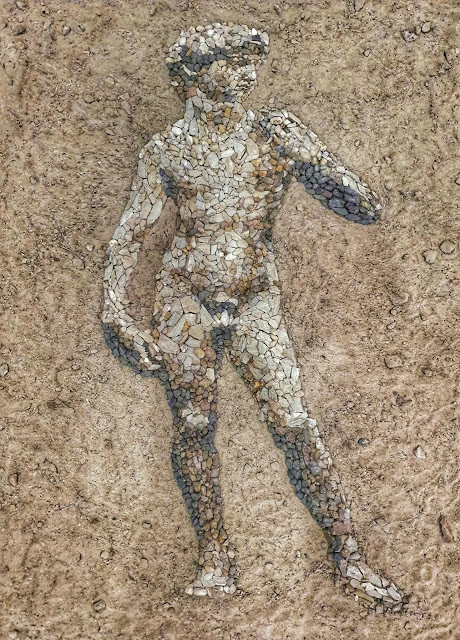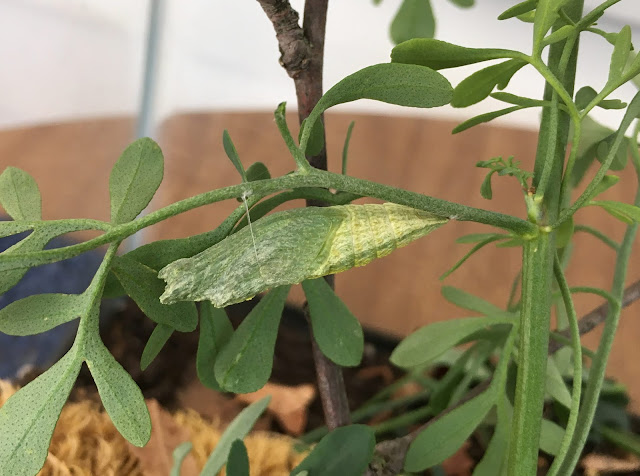31 July 2021
"Mommy, what's a tentacled microdroplet?"
30 July 2021
Memorable movie shots
"Rogue" planets are common
As reported by Gizmodo:
Rogue planets, as they’re informally known, likely formed from a protoplanetary disc around a host star but were then tossed out into interstellar space by the gravitational perturbations of larger planets. These wanderers range in size from Earth-like through to Jupiter-scale behemoths. Fascinatingly, they might be exceptionally abundant, with some scientists estimating trillions of them in the Milky Way. Their true population size remains a mystery, however...
As Einstein famously predicted, foreground objects can warp the light emanating from background stars. This results in the temporary magnification of the incoming light from our perspective, and the effect can last from just a few hours to a few days. Microlensing events are relatively rare, and those produced by rogue planets are even rarer...The new paper suggests the presence of a large population of Earth-sized rogue planets in the Milky Way. It’s becoming clear that free-floating planets are common. McDonald said his team is currently working to come up with a more precise estimate for how many of them might exist.
Hyperlexia
Zaila, who just finished eighth grade in her hometown, Harvey, La., showed a prowess for spelling at 10, when her father, who had been watching finals of the Scripps National Spelling Bee on ESPN, asked her how to spell the winning word: marocain.
Zaila spelled it perfectly. Then he asked her to spell the winning words going back to 1999. She spelled nearly all of them correctly and was able to tell him the books where she had seen them.
“He was a bit surprised by that,” Zaila said in an interview before the finals.She also learned how to speed read and figured out that she could divide five-digit numbers by two-digit numbers in her head, a skill she said she had a hard time explaining.
Hyperlexia is a syndrome characterized by a child's precocious ability to read. It was initially identified by Norman E. Silberberg and Margaret C. Silberberg (1967), who defined it as the precocious ability to read words without prior training in learning to read, typically before the age of 5. They indicated that children with hyperlexia have a significantly higher word-decoding ability than their reading comprehension levels. Children with hyperlexia also present with an intense fascination for written material at a very early age.Some hyperlexics, however, have trouble understanding speech. Some experts believe that most children with hyperlexia, or perhaps even all of them, lie on the autism spectrum. However, one expert, Darold Treffert, proposes that hyperlexia has subtypes, only some of which overlap with autism. Between 5 and 20 percent of autistic children have been estimated to be hyperlexic.
Correlation of vaccination levels with politics
27 July 2021
"Humped bull with gold horns"
Banded agate and goldHarappan period, About 1800 BCPur village, Bhiwani Khera, Haryana, IndiaHaryana State Archaeology and MuseumsSeveral Harappan sites have yielded gold jewellery that was often found in burial contexts. Much of this jewellery was made of expensive materials, which were imported from different parts of the world. The recent discovery of the tiny bull found in Haryana reveals gold horns, which were also common in West Asia. It is made of banded agate, which was quarried in distant places such as Gujarat and Maharashtra.
The most yellow icterus I have ever seen
Drop crotch skinny jeans - updated
Available from Oak (marked down from $158 to $79). They also have drop crotch sweat pants on sale for half-price at $64:
I can't advise you as to whether the heels are part of a coordinated look, but I do know that for drop crotch jodhpurs, you'll need to go to Comme des Garçons:
Also available for half price at $298. It would make me wonder if the wearer had scrotal elephantiasis, but then I'm not up on fashion, so I'll leave the commenting to those of you with a more enlightened and contemporary viewpoint.
Via The Stir.
Uppity employees demand a day off each week
Hundreds of Frito-Lay employees are returning to work in Kansas, ending a 19-day strike with the weekend ratification of a two-year contract that guarantees them at least one day off each week and raises wages...Workers at the Topeka plant had called on the snack food giant to end forced overtime and 84-hour workweeks, saying they had been pushed to the brink as the factory revved up operations during the pandemic, according to the Bakery, Confectionery, Tobacco Workers and Grain Millers International Union Local 218...Frito-Lay, the maker of Cheetos, Doritos, Ruffles and other packaged foods, is a unit of PepsiCo, the New York-based food and beverage giant. The snack business has seen strong sales throughout the pandemic as people spent more time at home and continues to gain market share. It brought in $4.5 billion in the second quarter, accounting for 23 percent of PepsiCo’s revenue.
Metal clamps in ancient megaliths
"The use of metal clamps in T-Grooves has been discovered in Tiahuanaco, Ollantaytambo, Koricancha, and the site of Yuroc Rumi, Vilcabamba. These clamps were also used on the Parthenon, on buildings in Mesopotamia, Egypt, and Cambodia...
Unfortunately, very few of the clamps have survived. The Spanish removed many clamps, thinking they might be gold. Some may indeed have been decorated with silver and gold, because it’s well-documented that armies set about demolishing these structures, just for the clamps...At first, archaeologists believed that clamps were brought to these grooves to be placed, but recent scans have revealed that metal was poured into these indentations, which means the builders had portable smelters...:
23 July 2021
Moths as food - and as navigators
Ethnographic accounts from around the world have reported the widespread use of insects as food by people. In some cases, such as among the Shoshone and other Great Basin tribes of the U.S., swarms of grasshoppers and crickets were driven into pits and blankets, while among the Paiute the larvae of Pandora moths (Coloradia pandora lindseyi) were smoked out of trees to fall into prepared trenches, where they would be cooked. Across the world, insects could be mass-harvested, often seasonally, offering high nutritional value especially in fat, protein and vitamins...In Australia, a wide range of insects is known to have been eaten by Aboriginal groups, in particular the larvae (‘witchetty grubs’) of cossid moths (especially Endoxyla leucomochla) in arid and semi-arid areas. Of particular interest to archaeologists and behavioural ecologists has been the seasonal consumption of Bogong moths by mass gatherings of Aboriginal groups in the southern portions of the Eastern Uplands...Here we report on microscopic remains of ground and cooked Bogong moths on a recently excavated grindstone from Cloggs Cave, in the southern foothills of the Australian Alps. These findings represent the first conclusive archaeological evidence of insect foods in Australia, and, as far as we know, of their remains on stone artefacts in the world. They provide insights into the antiquity of important Aboriginal dietary practices that have until now remained archaeologically invisible.
Each spring (September), Bogong moths migrate south over 1000 km from warmer climes. Travelling at night, the moths’ journeys last many days, arriving in the Australian Alps where, over the summer months (late September–March), they lie dormant (aestivate) in the hundreds of thousands among the protected rocky outcrops...
"In spring, the moths travel from various parts of eastern Australia to the Australian alps, where they inhabit caves. Over the summer they go into a kind of dormancy known as aestivation. This is much like hibernation, however it occurs in some animals over hot and dry periods rather than cold. At the end of the summer, bogong moths take a second long journey and head back home. They then breed and die soon after that. It’s a short but arduous life. The following year’s big migration is taken by the next generation of bogong moths...
The big question is: how do they know where the mountain caves are and how to get there when they have never been there before? Do they somehow inherit the information from their parents?Professor Eric Warrant and his team have found that the secret to the moth’s navigational skills is an ‘internal compass’ which they use to navigate the Earth’s magnetic field... As bogong moths are night-time travellers, the Moon or the Milky Way are useful points of direction, along with features of the landscape. "
Woman fails to prove the vaccine made her magnetic
CLEVELAND, Ohio (WOIO) - A woman who identified herself as a nurse practitioner student tried to defend an Ohio doctor’s unproven claim by proving she actually is magnetic after receiving the COVID-19 vaccine... Overholt used her time at the podium to try to defend a myth shared by Cleveland-area physician Dr. Sherri Tenpenny, who claimed that the COVID-19 vaccine leads to magnetism and causes metal objects to stick to the shot recipient’s body...During the demonstration, Overholt tried to prove Dr. Tenpenny’s point to be true by sticking a key and bobby pin to her skin at the hearing for the “Enact Vaccine Choice and Anti-Discrimination Act.”“Explain to me why the key sticks to me. It sticks to my neck, too,” Overholt said. “If somebody could explain this, that would be great.”Both objects fell off Overholt’s skin.
The geology of Mars
Why, for instance, does Earth have a magnetic field, but Mars’ seems to have disappeared? Why are so many volcanoes spread all over Earth, while volcanoes are more localized—and bigger—on Mars? (At 374 miles in diameter and 16 miles high, Olympus Mons is the biggest known volcano in the solar system.)..The researchers found the core density to be surprisingly low, at only about 6 grams per cubic centimeter, which is much lower than what they’d expected of an iron-rich center... In Stähler’s team’s paper, they report a core radius of 1,830 kilometers. Another team, led by ETH Zürich geophysicist Amir Khan, found that this size is so large it leaves little room for an Earth-like lower mantle, a layer that acts as a heat-trapping blanket around the core... Without this layer, the Martian core likely cooled much more readily than Earth’s. This is key to understanding the evolution of the Red Planet, and in particular why it lost its magnetic field, a barrier that would have protected the atmosphere—and potential life—from harsh solar winds. Creating a magnetic field requires a temperature gradient between the outer and inner core, high enough to create circulating currents that churn the core’s liquid and give rise to a magnetic field. But the core cooled so fast that these convection currents died out...Khan’s analysis also shows that Mars has a thick lithosphere, the rigid and cold part of the mantle. This might be a clue as to why the Red Planet doesn’t have the plate tectonics that drive the frenzy of volcanism on Earth. “If you have a very thick lithosphere, it's going to be very difficult to break this thing up and create the exact equivalent of plate tectonics on Earth,” says Khan. “Maybe Mars had it very early on, but it's certainly shut down now.”
22 July 2021
A very unusual Siberian cenotaph
The story of this remarkable finding began in 1968. A man’s sculptured head was discovered at the Shestakov burial ground located on the right bank of the River Kiya, not far from the village of Shestakovo, Kemerovo Oblast... In the kurgan where the head was found, inside the burial pit, there was a four-set timber blocking. On its bottom were small pieces of charred bones arranged in large assemblages. Supposedly, from 13 to 15 people were buried there. Next to the timber blocking wall, buried in a layer of red dead-burned clay, was the head, which must have been part of a burial doll of which nothing was left when the tomb was burnt (Martynov, 1974).The very first publications dedicated to this finding noted that “inside the head, as the X-ray photograph shows, there are skull bones and a small hollow space, which, however, does not correspond to the inner size of the human skull but is much smaller”...What does the sheep’s skull hidden under the clay covers depicting a man’s face tell us? What is it, an accident? Or was the animal the main hero of ancient history?The latter hypothesis seems justified. A ram (sheep) is among the most worshipped animals of old times. Initially, the Egyptian god Khnum was depicted as a ram (later, as a man with the head of a ram)... Later, Amun – the sun god, whose sacred animal was a ram – was identified with Khnum. Amun himself was often depicted as a ram or with the head of a ram. Deification of the pharaoh, worshipped as god’s son in flesh, was also connected with Amun... the Iranian-speaking Scythian-Sarmat communities had the cult of hvarnah, a special deity incarnating glory, grandeur, might, happy destiny, luck, richness, and power. Its zoomorphic image and symbol is a big and strong ram.
Now let us go back to our find. So in a burial crypt of Tagarsk culture, together with people, a sheep in human disguise was buried... The Tesinsk people may have buried in this extraordinary manner a man whose body had not been found (the man could have got lost in the taiga, drowned, or disappeared in alien lands). The man was thus replaced with his double – the animal in which his soul was embodied...Archaeologists know a number of such burials, referred to as cenotaphs, which have no human remains but may contain a symbolic replacement.
Housing density. And "living apart together"
Cohabitation, for example, is more often replacing remarriage following divorce or widowhood, said Susan L. Brown, a sociologist at Bowling Green State University in Ohio.These older adults are seeking (and finding) love, emotional support and an antidote to loneliness. But many older women, in particular, fear that a romantic attachment in later life will shortly lead to full-time caregiving...“A big attraction of LAT is to avoid the potential responsibility of being a full-time caregiver,” said Ingrid Arnet Connidis, an emerita sociology professor at Western University in London, Ontario. “Women cared for their children, parents and spouse, and want to avoid getting into these traditional gender roles.”
Citizens protest about water scarcity in Delhi
19 July 2021
Ocean jasper
Ocean Jasper is a trademarked name for a multicolored stone from Madagascar, typically with spherical patterning. Although commonly described as an orbicular jasper, the most recent research suggests it is the mineral chalcedony...
Wine storage room in California
(click photo to supersize)
Last September, a wildfire tore through one of Dario Sattui’s Napa Valley wineries, destroying millions of dollars in property and equipment, along with 9,000 cases of wine.November brought a second disaster: Mr. Sattui realized the precious crop of cabernet grapes that survived the fire had been ruined by the smoke. There would be no 2020 vintage.A freakishly dry winter led to a third calamity: By spring, the reservoir at another of Mr. Sattui’s vineyards was all but empty, meaning little water to irrigate the new crop.Finally, in March, came a fourth blow: Mr. Sattui’s insurers said they would no longer cover the winery that had burned down. Neither would any other company...... in 2008, smoke from nearby fires reached his grapes for the first time. The harvest went on as usual. Months later, after the wine had aged but before it was bottled, Mr. Smith’s brother, Charlie, noticed something was wrong. “He said, ‘I just don’t like the way the reds are tasting,’” Stu Smith said.At first, Mr. Smith resisted the idea anything was amiss, but eventually brought the wine to a laboratory in Sonoma County, which determined that smoke had penetrated the skin of the grapes to affect the taste.What winemakers came to call “smoke taint” now menaces Napa’s wine industry.“The problem with the fires is that it doesn’t have be anywhere near us,” Mr. Smith said. Smoke from distant fires can waft long distances, and there is no way a grower can prevent it.Smoke is a threat primarily to reds, whose skins provide the wine’s color. (The skins of white grapes, by contrast, are discarded, and with them the smoke residue.)
The face of child labor
"Iqbal Masih was born in 1983 in Muridke, a commercial city outside of Lahore in Punjab, Pakistan to a Christian family of low socioeconomic status. At the age of four, he was sent to work by his family to help them pay off their debts. Iqbal's family borrowed 600 rupees (less than US$12.00) from a local employer who owned a carpet weaving business. In return, Iqbal was required to work as a carpet weaver until the debt was paid off. Every day, he would rise before dawn and make his way along dark country roads to the factory, where he and most of the other children were tightly bound with chains to the carpet looms to prevent escape...At the age of 10, Iqbal escaped his slavery... and attempted to report his employer Ashad to the police, but the police brought him back to the factory seeking a finder's fee for returning escaped bonded labourers. Iqbal escaped a second time and attended the Bonded Labour Liberation Front (BLLF) school for former child slaves and quickly completed a four-year education in only two years. Iqbal helped over 3,000 Pakistani children that were in bonded labour escape to freedom and made speeches about child labour all over the world."Iqbal Masih, a brave and eloquent boy who attended several international conferences to denounce the hardships of child weavers in Pakistan, was shot dead with a shotgun while he and some friends were cycling in their village of Muridke, near Lahore."Iqbal was fatally shot by the "carpet Mafia", while visiting relatives in Muridke on 16 April 1995. He was 12 years old at the time..."
World cruise - $199,999 per person
Regent Seven Seas Cruises released the fares for sale at 8:30 a.m. ET Thursday. By 11 a.m., all the spots had been snapped up by people eager to spend more than four months on a cruise ship.
In celebration of Julia Child's 100th birthday
In celebration of her 100th birthday, Julia Child Remixed by John D. Boswell, aka melodysheep, for PBS Digital Studios. Please support your local PBS station: http://www.pbs.org/donate.Via The Dish.
Accessing the nasopharynx - updated
I have no doubt that a lot of the nasopharyngeal sampling being performed around the country is collecting inadequate and potentially misleading material.
The image embedded above is a enhanced photograph showing that access to the nasopharynx is straight back - along the roof of the mouth - NOT upward toward the brain.
The white tip of the swab in the photo is touching the nasopharynx, where Covid-19 lives. The virus may or may not also be present in the anterior nares, and I will bet a dollar to a doughnut that lots of swabs are giving false negative results because the sinus and turbinate area is swabbed, not the nasopharynx.
A full 5-minute video (from which the screencap above was taken) is available for viewing at The New England Journal of Medicine - along with detailed information about protection for the medical worker and processing of the specimen. Note for example the procedure for removing PPE optimally utillizes three pairs of gloves:
Remove your PPE as shown in the video and described here or in accordance with the standards at your institution. First, remove your gown and gloves. Clean your hands with an alcohol-based solution or soap and water. Put on a new [second] pair of gloves, and then remove your face shield and either dispose of it or clean and store it in accordance with the guidelines at your institution. Remove your gloves, rewash your hands, and put on another [third] pair of gloves; then remove your mask and follow your institutional guidelines for disposal or reuse. Finally, remove the last pair of gloves and wash your hands.Reposted from April of 2020 to add this disappointing screencap from a BBC video:
18 July 2021
Pondering the fate of the necktie
As America struggled to recover from a global pandemic, a shattered economy, and record unemployment levels, headlines despaired: “neckties doomed.” Men were “slashing their clothing bills” to retailers’ chagrin, the Associated Press reported. Those who continued to wear ties were downgrading from colorful, expensive silk to plain, cheap cotton. The year was 1921, and reports of the tie’s death were premature, to say the least.A century later, as Americans begin to emerge from another financially devastating pandemic, another rash of headlines is predicting the tie’s imminent demise... For more than a year, many men who once felt bound to wear ties have shown up on Zoom each day wearing polos or even T-shirts. Now that they have tasted freedom from the necktie—and have seen their colleagues, clients, and bosses doing the same—how can they ever go back to working with their necks encumbered?...The deeper functions that ties have long provided—such as social signaling and personal expression—will be absorbed by other garments. But ties will continue to be worn on the most formal occasions, and as quirky accoutrements for the self-consciously old-fashioned or whimsical. In other words, neckties are the new bow ties...... from the beginning, the necktie has also been an important emblem of both group identity and individual taste, sending subtle signals about the wearer’s wealth, social affiliations, culture, and intellect... A tie might indicate loyalty to a prestigious school, club, sports team, or military regiment. Beyond these flattering associations, a tie was a marker of maturity and respectability; it set management apart from manual laborers... The 1960s fashion designer Mary Quant neatly summed up the tie’s psychological import as “something between a comfort blanket and a public penis.”..
Who decapitated the wasp?
15 July 2021
Newest addition to our family - updated
12 July 2021
Modern treasure
"An unopened copy of Nintendo’s The Legend of Zelda that was made in 1987 has sold at auction for $870,000.Heritage Auctions in Dallas said the video game sold Friday. The auction house said it was a rare version that was created during a limited production run that took place during a few months in late 1987."
Treasure chest
It began with an unmarked, unremarkable box tucked in a corner of a garage in California. Inside, under miscellaneous letters and old high school yearbooks, was a smaller shoe box. Inside that, under old coins and a numismatist pamphlet, lay the 240-year-old diary of sailor John Claypoole, a Revolutionary War prisoner of war and later the third husband of the flagmaker known as Betsy Ross.“It was wrapped in a piece of paper that said, ‘John Claypoole diary to be handled with great care,’ which was sort of funny we found it in a paper shoe box in a box in this garage,” recalled Aileen Edge, who with her husband uncovered the priceless item in her mother’s Marin County home in June 2020...Growing up in Marin County, Calif., Aileen Edge always knew she was a direct descendant of John Claypoole and Betsy Ross, who was formally known as Elizabeth Griscom Ross Ashburn Claypoole when she died in 1836 at age 84. Edge’s mother, Claire Canby Keleher, was the famous flagmaker’s great-great-great-granddaughter and fiercely proud of her family’s role in the nation’s birth.
A map with no mistakes - updated
Calculating the volume of a pizza
Beware of browntail moth caterpillars
“Browntail-moth-caterpillar hairs are barbed and hollow. And inside that hollow tube, there’s a reservoir of a toxin,” says Allison Kanoti, the state entomologist for Maine, which is in the middle of a massive browntail-moth outbreak...Portland, Maine’s largest city, has had to temporarily relocate its farmers’ market to avoid the insects’ uncanny habit of dropping down from the trees where they nest. In June, Waterville, a city of 16,000, declared a public emergency because of the caterpillars. And all across the state, shoppers covered in itchy abrasions have stripped drugstore shelves bare of witch hazel and cortisone, key ingredients in a DIY compound designed to soothe the downy beast’s ferocious burn. Brushing up against a browntail-moth caterpillar or otherwise encountering its hairs—on a picnic table, on a dock, on a bit of clothes hung out to dry—can leave a person itching for days as a poison-ivy-like rash creeps across the flesh. And as the caterpillar sheds its hairs, they can go airborne, causing wheezing if they’re inhaled. Both reactions can be so severe it necessitates a trip to the emergency room. Research suggests that getting a hair of a browntail-moth caterpillar in your eye can even cause blindness (though this is exceedingly rare). The hairs can remain toxic for up to three years.“It spread pretty rapidly over 15 years from Massachusetts, to Long Island up into Vermont, New Hampshire, Maine, all the way over to New Brunswick, Nova Scotia, and into Canada,” Angela Mech, an assistant professor of forest entomology at the University of Maine, told me. “It was a huge nuisance.”...The health risk, at least, is seasonal. By late June the caterpillars have entered their cocoons in preparation of becoming moths, and the caterpillars that hatch from eggs in the late summer or early fall aren’t yet poisonous. Their toxins emerge over months as the caterpillars grow in their winter webs, shedding old skin, and revealing a larger new skin underneath, before becoming toxic shortly after they emerge from their webs in April...During the initial outbreak in the 1890s, the browntail-moth caterpillars caused so much havoc that, according to Mech, kids were paid to clip down their tents in winter. In a single year more than 24 million browntail-moth webs were clipped off trees and burned, while federal and local governments introduced dozens of different biocontrol agents, including predator insects from Europe... a fungus known as Entomophaga aulicae [is a natural adversary]. Once it takes hold, it can wipe out entire caterpillar colonies. But the fungus needs cool, wet springs to thrive. And Maine, which is located in the fastest-warming region in the lower 48 states, has experienced warm springs in the past few years.
10 July 2021
Spiny orb-weaver spider
Macracantha is a genus of Asian orb-weaver spiders recognized as containing a single species, Macracantha arcuata... notable for the extremely long, curved spines on the abdomens of female members of the genus; Eugène Simon created the taxon name from the Greek words μακρός (large, long) and ἄκανθα (spine). It occurs from India and China through Southeast Asia to Borneo.
Having fun at an abandoned Soviet labor camp
"After the seizure of the Baltic states by the USSR, a maximum security prison had been established by the quarry at Rummu [Estonia]. The area was turned into a secure compound, where the incarcerated were used as forced labour. Post-USSR, the prison was closed and the pits flooded. Although the land is privately owned, over time it had become a favourite spot for residents and visitors to swim and relax in."
Rhinoplasty - 1597
The tome, which is written in Latin, is illustrated with diagrams, including the rhinoplasty, in which the patient's nose was attached to a flap of skin from his upper arm. In one plate, the patient is seen in bed with his forearm attached to his head and a flap of skin from his bicep region stuck onto his nose.The technique used then is not widely dissimiliar from how some reconstructions are facilitated today. Facsimiles of the book can be purchased at Amazon ($250), or browsed at Google libri.
The book tells how he stayed like that for about three weeks until the skin from his arm had attached itself properly. After a further two weeks the flap of skin was shaped so it resembled a nose and the process was complete.
The book was sold for £11,000 to a modern-day plastic surgeon.
Inca trepanation
"Many of the oldest skulls showed no evidence of bone healing following the operation, suggesting that the procedure was probably fatal.
But by the 1400s, survival rates approached 90 percent, and infection levels were very low…
Their survey found that trepanation was a remarkably common practice in the Inca capital. Of 411 skulls that were sufficiently well preserved to study, 66 had holes cut through the bone. In one location, 21 of 59 skulls—over a third—had received trepanation.
While methods of trepanation varied over time, Inca surgeons eventually settled on a scraping technique to penetrate the skull without causing wider injury…
Some of the skulls had been perforated more than once, including one individual who had undergone the operation seven times…
Archaeologists have long debated whether the skull perforations were conducted as a medical procedure or for ritual or cultural reasons… Nearly all of the surgeries were performed either near the middle of the skull or on the left side—the regions most likely to be injured during combat with a right-handed opponent…
The fact that 19 of the surgical patients were women, however, suggests that the operation may have sometimes been performed for other reasons—possibly as an attempted cure for epilepsy or chronic bone infection..."
Where not to "get away from it all"
Hikers at Zion National Park, in Utah, have faced wait times of four hours to access certain trails. Visitors to Arches National Park, in the same state, are being turned away at the gate... Yellowstone set visitation records this May, hosting 483,159 visitors.


















































